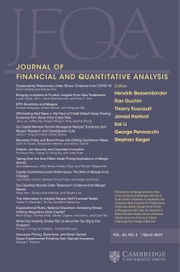Article contents
Outside Employment Opportunities and Tournament Incentives
Published online by Cambridge University Press: 09 June 2025
Abstract
We find that firms enlarge the executive pay gap when executive mobility is constrained by more enforceable noncompete agreements. We interpret this finding as evidence that firms increase tournament incentives to keep executives incentivized after the loss of valuable outside employment options. Consistent with this argument, we observe more significant increases in pay gaps for executives with greater ex ante mobility options. However, shocks reducing enforceability have a weaker, less robust impact on pay gaps, contributing to asymmetric effects. Following restrictions to mobility, equity portfolios that long (short) firms that boost (do not boost) executive pay gaps generate positive alphas.
Information
- Type
- Research Article
- Information
- Creative Commons
- This is an Open Access article, distributed under the terms of the Creative Commons Attribution licence (http://creativecommons.org/licenses/by/4.0), which permits unrestricted re-use, distribution and reproduction, provided the original article is properly cited.
- Copyright
- © The Author(s), 2025. Published by Cambridge University Press on behalf of the Michael G. Foster School of Business, University of Washington
Footnotes
We have benefited from insightful and constructive feedback from an anonymous referee and Ran Duchin (the editor). We are also grateful for the helpful comments and suggestions from Ying Cao, Zhaozhao He, Niels Hermes, Bjørn Jørgensen, Clemens Mueller, Fernando Rios-Avila, Wei Shi, conference participants at the AfriMed Finance Society, American Finance Association (Poster Session), American Law and Economics Association, China Finance Review International & China International Risk Forum, EUROFIDAI-ESSEC Paris December Finance Meeting, European Accounting Association, International Corporate Governance Society, and Southern Finance Association, seminar participants at the Copenhagen Business School, University of Cardiff, and University of South Carolina, and colleagues at the University of Manchester. We also thank the American Law and Economics Association for recognizing this article as the Best Paper in Employment Law, Labor Law, and Family Law at their 2023 Annual Meeting. The usual disclaimer applies.
References
- 1
- Cited by

